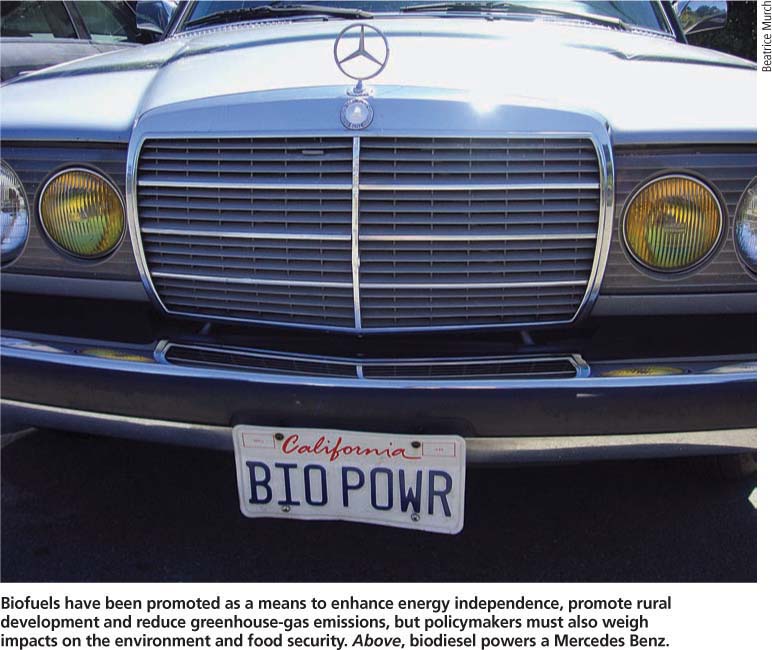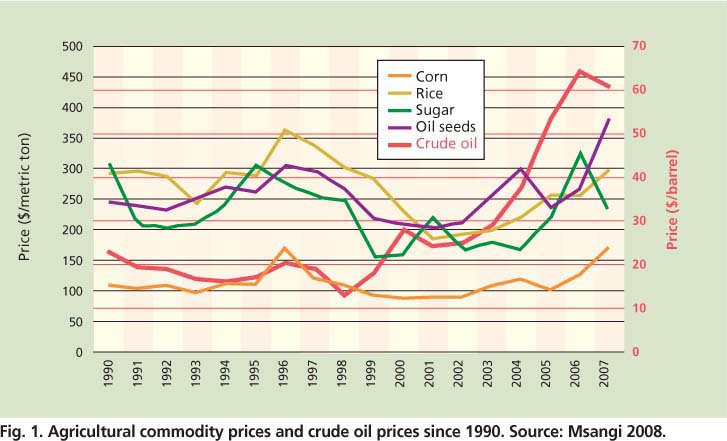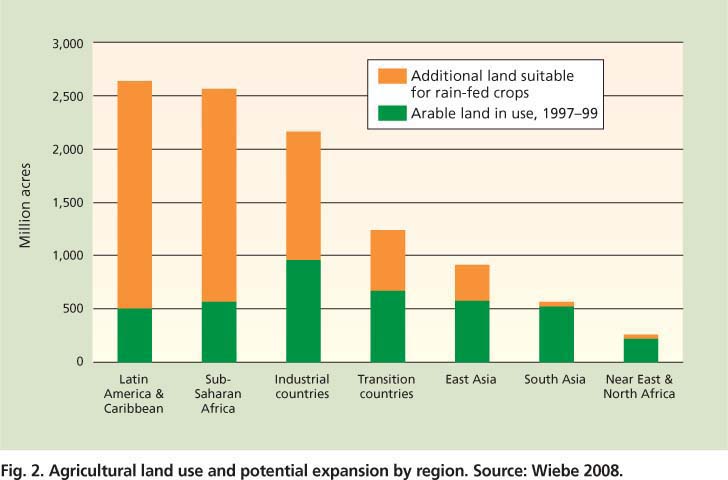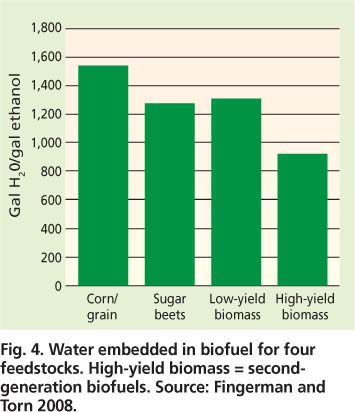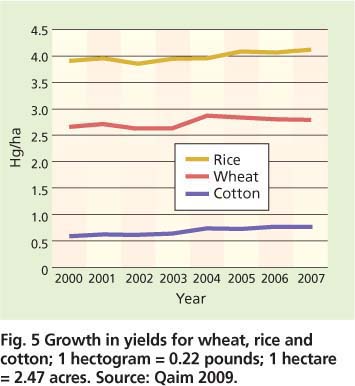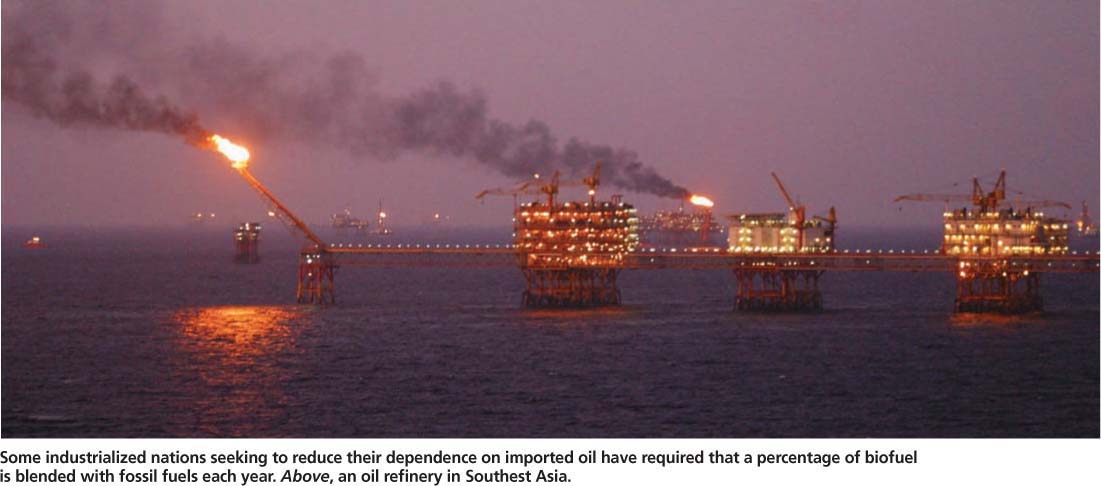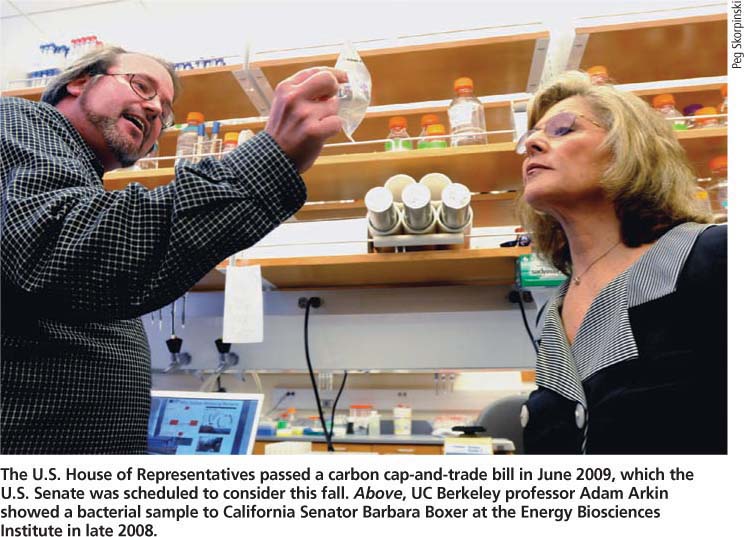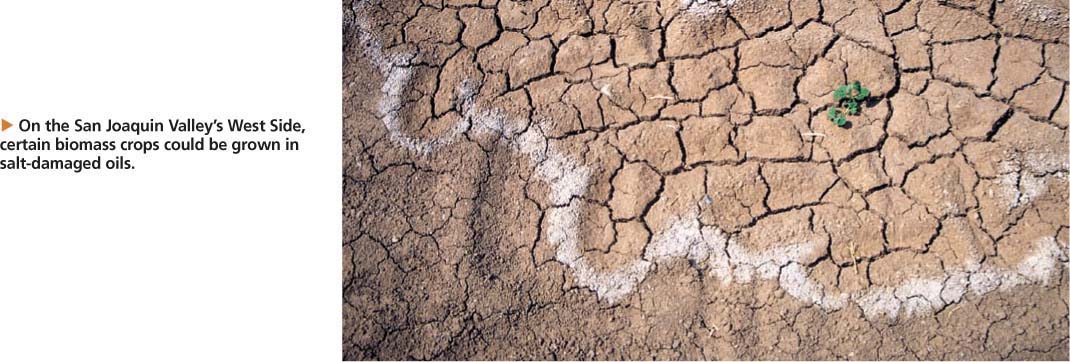All Issues
Biofuel policy must evaluate environmental, food security and energy goals to maximize net benefits
Publication Information
California Agriculture 63(4):191-198. https://doi.org/10.3733/ca.v063n04p191
Published October 01, 2009
PDF | Citation | Permissions
Abstract
The biofuel industry has received billions of dollars in support from governments around the world, as political leaders respond to new environmental and energy-security imperatives. However, a growing body of research highlights nontrivial costs associated with biofuel production, including environmental destruction and diminished food security, and questions the magnitude of perceived benefits. We discuss the ability of biofuels to accomplish climate change, rural development and energy-security objectives, and consider possible impacts on food production and environmental conservation. We also review methods for judging biofuels, consider how well they contribute to policy objectives, and compare policies that support biofuels.
Full text
Governments in industrialized countries have promoted the production of ethanol and biodiesel in order to mitigate climate change, boost income in the rural sector and reduce dependence on imported oil. The total outlays for these policies are measured in tens of billions of dollars per year. As the world emerges from the first global food crisis in three decades and controversy surrounds the greenhouse-gas savings of biofuels, policymakers have begun to question their promotion of a technology that takes land away from two predominant uses — food production and environmental preservation.
Biofuels have been promoted as a means to enhance energy independence, promote rural development and reduce greenhouse-gas emissions, but policymakers must also weigh impacts on the environment and food security. Above, biodiesel powers a Mercedes Benz.
Governments that seek to introduce alternative fuel policies do so despite a lack of consensus among researchers as to the costs and benefits of biofuel production. Impacts are mostly predicted through complex economic models based on numerous assumptions, many of which are open to critical review. Furthermore, the impacts of biofuels on climate change, food prices, deforestation and energy security vary by feedstock, and method and location of production, making it difficult to draw general conclusions, and complicating policy development.
Why biofuels?
The biofuel industry has benefited from government policy since the energy crisis of 1973, which disrupted a half-century of cheap oil and awakened oil-importing countries to their dependency on oil-rich nations. In recent years, concern has grown about global climate change as well as national security during an era of increasing energy demand and rapidly rising energy prices. As a result, the United States, European Union (EU), Australia, Canada and Switzerland spent at least $11 billion on biofuel subsidies in 2006 (GSI 2007).
Rural and agricultural development.
Because bioenergy creates additional demand for crop production, biofuels may increase farm income and enhance development. Economic theory predicts that an increase in demand for a commodity increases its price, all else being equal. Farmers will enjoy higher prices, even if producers boost supply in response to higher prices, so long as supply increases less than demand. This theory is confirmed by rising world prices for several staple agricultural commodities (fig. 1). U.S. corn prices, for instance, averaged $4 per bushel in 2008, up from $3.40 in 2007 (USDA 2008b).
World prices for staple agricultural commodities have risen considerably in recent years (fig. 1). Rising crop prices can contribute to improved welfare on the farm, but may also be capitalized into land rents and the price of other inputs (from machinery to chemicals), reducing the benefit to farmers. Nevertheless, U.S. farm income was an estimated record $89.3 billion in 2008, up roughly 50% from its 10-year average. Average farm household income was an estimated $89,434, nearly 20% above the 5-year average from 2001 to 2006 (USDA 2008a). Benefits will not be uniformly distributed among farmers, however; while row-crop producers will benefit from higher commodity prices, livestock farmers, in particular, are expected to suffer from rising feed costs.
Biofuels may help developing countries transition from subsistence farming. Many poor countries are unable to farm major food crops profitably due to poor climate and soil, but they can produce existing and second-generation bioenergy crops. Eighty developing countries, for instance, grow and process sugar cane, the most efficient feedstock used today in commercial ethanol production (IFPRI 2005). A second generation of biofuels will yield feedstocks that grow on marginal and degraded lands.
For example, Miscanthus can be grown on marginal land and irrigated with saline water and still yield significantly more ethanol per acre than existing feedstocks. Jatropha, an oil-bearing plant used to produce biofuel, can be grown on infertile soil and under drought conditions. An estimated 74 million acres (30 million hectares) of land could be planted to Jatropha in India (IFPRI 2005). Developing countries could have a comparative advantage in producing biofuel feedstocks largely due to lower opportunity costs of marginal land; bioenergy crops would not be displacing crops for food and feed (fig. 2). Notably, countries in South America and sub-Saharan Africa could quadruple their agricultural land base to accommodate bioenergy crops. This transition from subsistence farming could greatly boost welfare in poor countries, but the net welfare effect of biofuel on the poor hinges on the impact of rising food prices. The landless poor would not benefit from energy cash crops, but would suffer from higher food prices.
Energy security.
Since biofuels can be produced domestically in many countries, they may improve the energy security of oil-importing countries. With oil prices exceeding $130 per barrel in 2008 and much of the world's oil production occurring in politically unstable regions, governments aim to ensure that their economies are not held hostage. In theory, biofuels can serve as a substitute for fossil fuels and reduce oil imports.
Based on current production methodologies, however, most countries will be unable to displace any significant share of their oil consumption, and can, at most, hope to marginally reduce prices by increasing the supply of liquid fuels. For example, the United States, Canada and EU-15 (Austria, Belgium, Denmark, Finland, France, Germany, Greece, Ireland, Italy, Luxembourg, the Netherlands, Portugal, Spain, Sweden and the United Kingdom) could displace only 10% of their gasoline consumption with biofuels if they recruit between 30% and 70% of their respective croplands (Rajagopal and Zilberman 2007). The diversion of such significant shares of cropland is unlikely and would entail significant increases in food prices. Unless biofuel productivity improves, more cropland will be needed to displace the same share of gasoline as energy consumption rises.
Greenhouse-gas mitigation.
Concern about global warming has driven interest in fuels that emit less greenhouse gas than oil. The primitive view of biofuels, which has proven quite misleading in recent years, is that carbon is stored during energy-crop growth and later emitted during the combustion of biofuels in a carbon-neutral cycle. This simplistic analysis has been replaced with life-cycle analysis, which considers the greenhouse-gas emissions of an energy source throughout the entire process, including production (soil tilling, gas and diesel-powered farm equipment, emissions from fertilizer production and other inputs), conversion of the energy crop to biofuel, transportation of fuel to market, and fuel consumption.
While analyses differ, the literature suggests modest greenhouse-gas savings associated with the first generation of biofuels, primarily ethanol from corn and sugar cane, and biodiesel from soy and palm oil. Farrell et al. (2006) estimated that corn ethanol provides greenhouse-gas savings of 13% relative to fossil fuels. Hill et al. (2006) reported greenhouse-gas savings from biodiesel of 41% relative to traditional diesel fuel. Life-cycle analysis has generally shown that biofuels are not the global warming panacea many believed they would be, but they can constitute a partial solution. These analyses, however, typically do not account for “scaling up” effects, such as the conversion of land in its natural state, with its existing carbon sequestration functions, to biofuel feedstock production.
Negative implications of biofuels
While biofuels provide benefits, they are also associated with significant costs. First, they can be damaging to the environment — they may actually increase greenhouse-gas emissions, increase car travel, reduce biodiversity, consume scarce water supplies and degrade water quality. Second, as energy production competes with food for harvests and land, food production declines and prices go up. Biofuels are surely responsible, in part, for the food crisis of 2008, during which three decades of declining food prices abruptly gave way to dramatic price increases as food inventories were drawn down to historic lows and food-producing countries imposed export controls to protect domestic markets. The blame for the food crisis attributed to biofuels from media reports is, however, likely overstated.
Greenhouse gases.
Even the lifecycle analyses that reported only modest carbon savings from biofuels relative to fossil fuels (for example, Farrell et al. 2006 and Hill et al. 2006) may have overstated the climate change benefits. They ascribed a carbon credit to biofuels to account for sequestration that occurs during energy-crop growth, but failed to account for the loss of carbon sequestration in forests and grasslands destroyed to make room for energy crops.
Searchinger et al. (2008) were the first to analyze the carbon emissions of corn ethanol and account for land-use changes. In particular, biomass sequesters carbon in forests and grasslands and stores it in plant material. If such lands are cleared and the biomass is burned or left to decompose, then the carbon is emitted back into the atmosphere. Because biofuels create additional demand for land, they theoretically lead to the expansion of cropland and the loss of natural lands. Searchinger et al. (2008) found that a 15-billion-gallon (56-billion-liter) expansion of U.S. corn ethanol production would bring an additional 26.7 million acres (10.8 million hectares) of land under cultivation and actually double carbon emissions relative to fossil fuels over 30 years. It would take 167 years for corn ethanol to overcome the carbon debt it incurs from land-use changes and start providing carbon savings (relative to fossil fuels). Switchgrass, which yields more ethanol per acre, could provide carbon savings within four decades (Searchinger et al. 2008).
Similar analysis by Fargione et al. (2008) concluded that the production of food-crop biofuels in the United States, Brazil and Southeast Asia would induce land-use changes that increase carbon emissions from 17 to 420 times the annual carbon savings of biofuels, depending on assumptions about land-use changes. Corn ethanol produced on abandoned U.S. cropland would repay its carbon debt after 48 years. Producing corn ethanol on converted grasslands would double the repayment time. Palm diesel produced on converted rainforest in Malaysia and Indonesia would not repay its carbon debt for more than four centuries.
Car travel.
Because biofuels reduce the price of transportation fuel by increasing supply (Rajagopal et al. 2007), they encourage additional car travel by gasoline consumers (Khanna 2008). In other words, biofuels increase vehicle miles traveled, which increases carbon emissions, worsens traffic congestion on roadways and can lead to additional traffic accidents (Khanna 2008; de Gorter 2008).
Biodiversity.
The 26.7 million acres of land that Searchinger et al. (2008) predicted would be newly cultivated for the production of 15 billion gallons of corn ethanol would not only increase greenhouse-gas emissions but also destroy natural lands and reduce biodiversity (Mooney and Hobbs (2000). De Fraiture et al. (2008) estimated that an additional 74 million acres of cropland would be needed to meet food and biofuel demand in 2030. Even without biofuels, agricultural production is considered the biggest source of nonclimatic environmental change. It is responsible for loss of habitat and introduction of invasive alien species, for instance (Tilman et al. 2001). Already, 70% of farmland in South Dakota that had been enrolled in the U.S. Conservation Reserve Program will not be re-enrolled as farmers seek to capitalize on high commodity prices.
The loss of natural lands inhibits the environment's ability to provide essential services, including waste assimilation, water purification, fire suppression, soil restoration, nutrient recycling, flood protection, drought prevention and carbon sequestration. Biodiversity also provides value associated with the opportunity to use resources in the future and value associated with the existence of species. Many breakthroughs in science, medicine and agriculture are the result of genetic discoveries in natural habitat (Balick 1996). The loss of biodiversity is costly and irreversible. And while there is hope that climate change can be reduced, there is no way to bring back an extinct species.
Fig. 4. water embedded in biofuel for four feedstocks. High-yield biomass = second-generation biofuels. Source: Fingerman and Torn 2008.
Water availability.
Water is needed to produce feedstocks as well as convert plant material into fuel (fig. 3). The conversion process is water-intensive and has sparked conflict among biorefineries and growers within watersheds. A recent study commissioned by the California Air Resources Board to investigate the water-resource implications of an increase in California's bioenergy production found impacts to be highly dependent on feedstocks (Fingerman and Torn 2008) (fig. 4).
On average, ethanol produced from feedstocks such as corn and sugarbeets consumes from 925 to 1,527 gallons of water per gallon of ethanol. In contrast, the amount of water required to produce the average daily diet in North America is 1,320 gallons, but less than 500 gallons in sub-Saharan Africa (Serageldin 2001). Evapotranspiration by energy crops constitutes much of the water consumed in biofuel production. By some estimates, the water consumed by energy crops through evapotranspiration could by 2110 meet and even exceed the total water used for evapotranspiration by global croplands in 2002 (Fingerman and Torn 2008).
Water quality.
Because agricultural production typically causes some environmental harm, such as soil erosion and pollution from chemicals, to the extent that biofuels increase the stock of productive land, they will increase the magnitude of these damages. Furthermore, as prices for agricultural commodities rise because of biofuel-induced demand, farmers will also find it profitable to use more chemicals per unit of land. Higher input prices could also induce the adoption of precision pest-control technologies, but unless such conservation is considerable, more chemical use will lead to increased pollution of water resources from farm runoff and groundwater percolation. Generally, however, biofuels cause increased environmental damage on both the intensive (more chemicals and erosion per unit of land) and the extensive (more pollution and erosion) margins.
Food security.
Perhaps the direst consequence of biofuel production is the pressure that it imposes on the food system. Whereas elevated carbon emissions have negative effects that will play out over decades and centuries, rising food prices and reduced food production mean that people today will potentially go hungry. To some extent, biofuel policies trade food in the stomach for fuel in the tank ( see page 199 ).
A key rationale for biofuel policy is economic development in underdeveloped countries and rural development in industrialized economies. But the food market impacts of biofuels constrain the welfare benefits to the poor. Higher output prices do not universally benefit even the rural poor (Wiebe 2008). For example, the rural poor suffer from higher food prices in countries like Bangladesh and Guatemala, while those in Madagascar and Ghana are better off because they grow more of their own food. The effect of food price increases is even worse for the urban poor, who suffer welfare losses across countries (Wiebe 2008).
Factors affecting biofuel impacts
Feedstocks.
Not all biofuel feedstocks are created equal. They vary in the amount of energy yielded per acre of land; the amount of inputs such as fertilizer, pesticides and water required in production; and the extent to which they compete with traditional agriculture for land. By all of these criteria, the second generation of biofuels (high-yield biomass) will fare better than existing biofuels. Plants like Miscanthus, switchgrass and Jatropha can greatly improve the carbon accounting of biofuels because they are less input-intensive and yield more biofuel per unit of land. Cellulosic ethanol from Miscanthus, for instance, can yield as much as three times the biomass per acre as traditional corn ethanol (table 1) ( see page 185 ). Because they are less land-intensive, second-generation feedstocks reduce pressure for the conversion of natural lands, which greatly reduces the carbon debt estimated by Searchinger et al. (2008).
Technology.
In the past half-century, growth in agricultural productivity has permitted gains in per-capita food production even as world population doubled. This achievement is even more remarkable considering that the agricultural land base shrank during that time. These gains are the result of mechanization, modern irrigation, chemical fertilizers and pesticides, and the Green Revolution, which capitalized on hybridization to create “super crops,” which have freed land for environmental conservation. Such success, however, may have bred a complacency about crop science that the world community can ill afford; there are 852 million undernourished people around the world and food production per capita is decreasing (FAO 2004). Though political considerations and distribution may be to blame for hunger, the situation will not improve as food becomes scarce.
The 2008 food crisis and slowing advances in crop productivity generally are likely the result of underuse of technology that permits the transfer of genes across plant species in a more rapid and deliberate process than conventional hybridization techniques. Whereas rice and wheat yields (fig. 5) have experienced slow growth in recent years, soybeans, corn and cotton have experienced consistent growth due to the adoption of agricultural biotechnology, which greatly improves yields and reduces pesticide use (Qaim 2009).
Fuel production.
Though demonstration projects are producing cellulosic ethanol on a small scale, more work must be done before such production can be scaled up ( see pages 178 and 185 ). The challenge is to identify genes, culture them and determine an industrial method of replicating what is already occurring in nature. This challenge creates an imperative for additional advances in biofuel technology so that the world can transcend the use of corn and soy and develop liquid fuels from more productive sources.
The carbon consequences of biofuels are also closely tied to production methods. To the extent that energy-efficient technologies are developed and deployed, and cleaner energy is used in production, the net carbon benefit of biofuels can be improved. For example, nitrogen fertilizer used on corn fields is produced from energy that is 90% gasoline and 10% coal; if fertilizer production were to rely entirely on coal power, the carbon benefit of the resultant corn ethanol would be 61% less (Zilberman 2008). In addition, reducing the distances that feedstocks are transported to refineries and that refined ethanol is transported to market will minimize carbon emissions.
Price and policies.
Biofuel impacts are a function of market conditions and policies that determine the prices perceived by market participants. Higher fuel prices and lower prices for agricultural commodities will tend to increase the land devoted to biofuels. If the price of cleaner fuels is less than the price of fossil fuels (perhaps because of policy), then consumption will shift to cleaner fuels — a “green-green” solution. Rising transportation fuel prices may lead to a reorganization of the industry to minimize transportation costs. As transportation costs are reduced, so too are carbon emissions, and the carbon balance of biofuels improves. The conversion of natural land can also be reduced by policies that provide payments for environmental services. Food impacts can be reduced by policies that tie biofuel support to food supply. For instance, subsidies and mandates used to promote biofuel production could be reduced when food inventories fall or food prices rise.
Fig. 5 Growth in yields for wheat, rice and cotton; 1 hectogram = 0.22 pounds; 1 hectare = 2.47 acres. Source: Qaim 2009.
Climate-change policy options
Biofuels have wide-ranging implications for the environment, food production, energy markets and economic growth, complicating the development of welfare-maximizing biofuel policies. In addition, biofuel impacts vary by feedstock, location, time and production process, further complicating the work of policymakers. Because the successful development of a robust biofuel industry requires coordinated adoption across a number of sectors and market participants (from farmers who must plant crops to fuel retailers who must develop capacity to sell new fuels and blends), government intervention may be needed at various stages of the supply chain. The aim of policy should be to temporarily promote biofuel technologies that will one day be competitive with fossil fuels and other alternatives, if externalities are corrected.
Carbon and land-conversion taxes.
In economics, policies are categorized based on their efficiency. First-best policies are those that achieve socially desirable outcomes with the least cost. Economists nearly universally agree that the first-best response to anthropogenic (human-caused) climate change is the imposition of a global carbon tax on each unit of emissions equal to the marginal externality cost (i.e. the climate change cost) of carbon emissions. Such a tax internalizes the externality (the harm to society above and beyond the harm to the emitter) associated with carbon emissions to the one who emits the carbon; it essentially corrects a market failure that does not require people to pay for releasing carbon into the atmosphere. Such a tax, known as a Pigouvian tax, would improve social welfare by reducing carbon emissions while creating no distortions in the economy. It would also generate government revenue that could be used to reduce other taxes that do cause distortions (deadweight loss), such as income, payroll and capital gains taxes.
Some industrialized nations seeking to reduce their dependence on imported oil have required that a percentage of biofuel is blended with fossil fuels each year. Above, an oil refinery in Southest Asia.
Equivalent to a Pigouvian tax under certain conditions, “cap-and-trade” systems have been favored by governments in the United States, Europe and elsewhere. The European Union implemented a cap-and-trade program in order to meet its Kyoto Treaty obligations. In June 2009, the U.S. House of Representatives passed a carbon cap and-trade bill that the U.S. Senate was set to consider in fall 2009. If the quota of emissions permits is set so that the price of a permit is equal to the Pigouvian tax, and if government auctions the permits, then the efficiency and distribution implications of cap-and-trade are identical to a first-best carbon tax.
A carbon tax or equivalent cap-and-trade program would induce a greater supply of clean energy by shifting production from fossil fuels to biofuels (assuming biofuels are at least somewhat cleaner) (Hochman et al. 2008). This, in turn, would induce land conversion and a loss of biodiversity as energy-crop production expands. Without proper valuations of natural habitat, a carbon tax would lead to more environmental destruction than is socially optimal. A carbon tax could actually reduce social welfare depending on whether biodiversity is more valuable to society than carbon emissions reductions. To ensure a welfare-maximizing outcome, a policy to price carbon emissions must be paired with one to price environmental services and biodiversity, such as a land-conversion tax or system to pay landowners for the environmental services they provide.
Furthermore, these policies should be adopted globally. Otherwise, a tax system in any one country will suffer “leakage” of carbon emissions and biodiversity loss outside its jurisdiction. Because carbon emissions are a global public “bad,” emissions anywhere harm people everywhere in the world. If a carbon tax makes emissions more costly in the United Kingdom, for instance, then emissions-intensive activities like industrial production will shift to countries that have not imposed such taxes or other regulations. As a result, carbon emissions would be reduced in the United Kingdom but not necessarily on a global level.
Fuel taxes.
A fuel tax is the second-best way to regulate carbon emissions. Because it is costly for regulators to monitor all sources of carbon emissions, a fuel tax may be preferred — fuel purchases are relatively easy to observe. Many countries and states already impose fuel taxes, though the taxes often are not set equal to the marginal externality cost of fuel consumption. A fuel tax should vary according to the class of fuel, with dirtier fuels taxed more heavily. Life-cycle analysis should be used to classify fuels according to carbon costs. A fuel tax, however, is inferior to a carbon tax because it targets an input (fuel) when it is the output (carbon emissions) that causes damage. Because carbon emissions are not strictly determined by fuel consumption, a fuel tax is inefficient. For instance, it does not provide incentives for the adoption of cleaner burning technologies that reduce carbon emissions per unit of fuel consumed.
Subsidies and mandates
Carbon and land-conversion taxes have not materialized in the United States because of political considerations and lack of coordination with other countries. Given the political difficulties associated with imposing first-best policies, we consider a class of policies that could be used to develop a renewable fuels industry — subsidies and mandates. Assuming greenhouse-gas savings from biofuels relative to the next-best alternative fuel, these policies can serve as an indirect and third-best (after carbon and fuel taxes) method of reducing greenhouse gases.
Economists generally prefer subsidies as a more market-oriented approach, but mandates may be preferable for biofuels. The United States has pursued both policies, offering a tax credit for blending biofuels in fossil fuels (a subsidy) and requiring certain quantities of biofuel blending each year (a mandate). Biofuel mandates can be preferable because they create a certain market for biofuels — producer profits are not tied directly to market forces in food and energy, such as fluctuating oil prices. By removing uncertainty about profits, they encourage innovation and capital investment. Mandates make demand for biofuels unresponsive to price. This means that rising food and energy prices induce agricultural intensification and productivity gains rather than the land expansion that is costly in terms of climate change and biodiversity (Babcock 2008). Because land expansion releases considerable carbon emissions, this is not a minor issue — it is critical to the carbon balance of biofuels. Finally, mandates are revenue neutral, whereas subsidies are deducted from the treasury. The cost of mandates is borne by producers and consumers, depending on the responsiveness of fuel supply and demand to prices. The cost of carbon-emissions reductions would be greater under mandates than under a carbon tax because mandates do not permit reductions in the least-cost way.
The U.S. House of Representatives passed a carbon cap-and-trade bill in June 2009, which the U.S. Senate was scheduled to consider this fall. Above, UC Berkeley professor Adam Arkin showed a bacterial sample to California Senator Barbara Boxer at the Energy Biosciences Institute in late 2008.
Biofuel subsidies, whether paid to producers or consumers, increase biofuel use, decrease gasoline use and have an ambiguous effect on greenhouse-gas emissions — arguably the main motivation for biofuels policy. In addition, subsidies create a less-certain market environment because the demand for biofuels is tied to their cost relative to oil. The cost of biofuel production is likewise dependent upon food market conditions because food and biofuels compete for land and harvest.
Any biofuel policy, whether based on taxes, mandates or subsidies, should take into account and vary according to the sustainability of biofuels in terms of carbon emissions, biodiversity, water and air pollution, and food availability. This means government support could be tied to net carbon benefits, yields per acre, the use of dedicated energy crops (as opposed to food crops) or crop residues and waste, and input-intensity of the feedstock conversion process. Life-cycle analysis can determine the net carbon benefits of biofuels, but it ignores other attributes of production that determine the sustainability of biofuels, such as impacts on food markets, the environment and natural resources. While more sustainable biofuels should receive larger mandates, regulators should recognize that transition technologies, such as corn ethanol, may be needed in the short run to ensure a transition to better-performing biofuels.
Investing in technology
Economic theory predicts underinvestment in biofuel and food technology for several reasons. Research and development are associated with spillovers, whereby others benefit from the innovation of an individual or firm, but do not pay a price for the benefits they enjoy. Innovating firms, therefore, do not capture all the benefits of their investment and will consequently underinvest in research and development relative to the optimal level (Naidiri 1993). Regulatory uncertainty creates further doubts as to whether private institutions will be able to capture sufficient benefits to compensate for their investments. Government intervention can essentially eliminate markets, and uncertain policy direction can slow innovation among risk-averse firms. Regulation and uncertainty have affected research and development in biofuels and agricultural biotechnology.
Private investment in agricultural biotechnology has fallen off considerably since the 1990s, in part because of a de facto ban on genetically modified organisms in the European Union that severely limited the market (Graff and Zilberman 2004). In addition, the emergence of some genetically modified organisms has been stalled because farmers can reproduce the seed, limiting the potential for firms to benefit from research and development. Finally, research is lacking to develop traits and seeds for developing countries because many of the countries cannot afford to pay for the innovations. Underinvestment in crop science creates a role for public investment in agricultural productivity, not just for the sake of bioenergy, but also human hunger. Public research universities have partnered with private companies for both biotechnology and biofuel research, leveraging public dollars with private dollars and capitalizing on the comparative advantage of university scientists in basic research. UC Berkeley, for instance, has entered into a 10-year, $500 million commitment with the oil firm BP to develop new fuel technologies.
Ensuring food security.
The ability to mitigate the food impacts of biofuels will be crucial to their future, and investment in crop and biofuel science should be viewed as policies to enhance food security. Agricultural productivity gains like those seen over the past half-century could free significant farmland for energy-crop production and still feed a world growing to 9 billion people by 2050.
Fuel technology that develops cellulosic ethanol can reduce pressure on food markets by permitting the use of agricultural waste products in biofuel production and by producing energy crops that yield more fuel per acre and can be grown on lands not suited for food crops. Food security also demands that biofuel policies be flexible and adjust to food market conditions. Subsidies and mandates could be tied to food inventories, for instance, in order to prevent food crises. This would, however, create a less certain market for biofuels and could slow innovation. Because the poor will most acutely be affected by pressure on the food system, biofuel policy should perhaps be coupled with mechanisms, such as a global food fund, to provide for vulnerable populations during periods of high food prices.
Balancing green energy needs
Biofuel policies should balance the demand for a green energy source today with efforts to improve biofuels in the future and the need to address food security concerns. Policy must address ways to improve the greenhouse-gas benefit of biofuels, reduce impacts on food markets and develop a biofuel industry. Policy is complicated by heterogeneity in biofuel costs and benefits — not all biofuels are created equal.
Current biofuels are far from perfect. But if the world turns its back on biofuels based on the impacts of transition technologies, then we must wonder what other fuels will be introduced to meet the growing demand for transportation energy (for fuel). These alternatives, like oil shale, may well be dirtier than traditional fossil fuels and existing biofuels.



